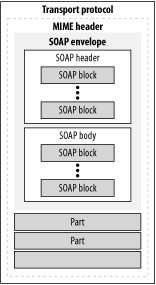SOAP with Attachments
While XML and SOAP are very good at describing data, many kinds of application data aren’t well-suited for XML—for example, a piece of binary data such as an image, or a CAD file that contains schematic diagrams of parts being ordered electronically. SOAP with Attachments (SwA) was born in recognition of this limitation. SwA combines the SOAP protocol with the MIME format to allow any arbitrary data to be included as part of a SOAP message. The model is exactly the same as the model used for including email attachments.
Parts Is Parts
The MIME protocol allows multiple arbitrary blocks of data to be strung together in a message, with each block separated by a MIME header. The MIME headers delineate where each part begins and the previous part ends. The next example shows what a MIME header looks like. In SwA, the entire message consists of multiple MIME parts; the first part (part 0) is the SOAP envelope, and the remaining parts (1 through n) are the attachments. All parts are wrapped by the underlying protocol, as illustrated by Figure 3-3.

Figure 3-3. The structure of a SOAP with Attachments message
To construct and deconstruct SwA messages, use the Apache SOAP and JavaMail APIs. Before running the example, note that the example archive contains a text file called attachment.txt. It is a simple text file that contains the string “This is an attachment.” There ...
Get Java Web Services now with the O’Reilly learning platform.
O’Reilly members experience books, live events, courses curated by job role, and more from O’Reilly and nearly 200 top publishers.

